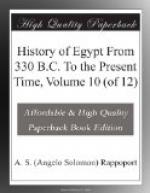[Illustration: 141.jpg Coin with the heads of Soter and Philadelphus and Arsinoe]
This seeming marriage, however, between brother and sister did not escape blame with the Greeks of Alexandria. The poet Sotades, whose verses were as licentious as his life, wrote some coarse lines against the queen, for which he was forced to fly from Egypt, and, being overtaken at sea, he was wrapped up in lead and thrown overboard.
In the Egyptian inscriptions Ptolemy and Arsinoe are always called the brother-gods; on the coins they are called Adelphi, the brothers; and afterwards the king took the name of Philadelphus, or sister-loving, by which he is now usually known. In the first half of his reign Philadelphus dated his coins from the year that his father came to the throne; and it was not till the nineteenth year of his reign, soon after the death of his mother, that he made an era of his own, and dated his coins by the year of his own reign. The wealth of the country is well shown by the great size of those most in use, which were, in gold the tetra-stater or piece of eight drachms, and in silver the tetra-drachma, or piece of four drachms, while Greece had hardly seen a piece of gold larger than the single stater. In Alexandrian accounts also the unit of money was the silver didrachm, and thus double that in use among the merchants of Greece.
[Illustration: 142.jpg COIN WITH THE HEADS OF SOTER, PHILADELPHUS AND BERENICE]
Among the coins is one with the heads of Soter and Philadelphus on the one side, and the head of Berenice, the wife of the one and mother of the other, on the other side. This we may suppose to have been struck during the first two years of his reign, in the lifetime of his father. Another bears on one side the heads of Ptolemy Soter and Berenice, with the title of “the gods,” and on the other side the heads of Philadelphus and his wife Arsinoe, with the title of “the brothers.” This was struck after the death of his parents. A third was struck by the king in honour of his queen and sister. On the one side is the head of the queen, and on the other is the name of “Arsinoe, the brother-loving,” with the cornucopia, or horn of Amalthea, an emblem borrowed by the queens of Egypt from the goddess Amalthea, the wife of the Libyan Anion. This was struck after his second marriage.
On the death of Arsinoe, Philadelphus built a tomb for her in Alexandria, called the Arsinoeum, and set up in it an obelisk eighty cubits high, which had been made by King Nectanebo, but had been left plain, without carving.
[Illustration: 143.jpg COIN OF ARSINOE, SISTER OF PTOLEMY II.]




